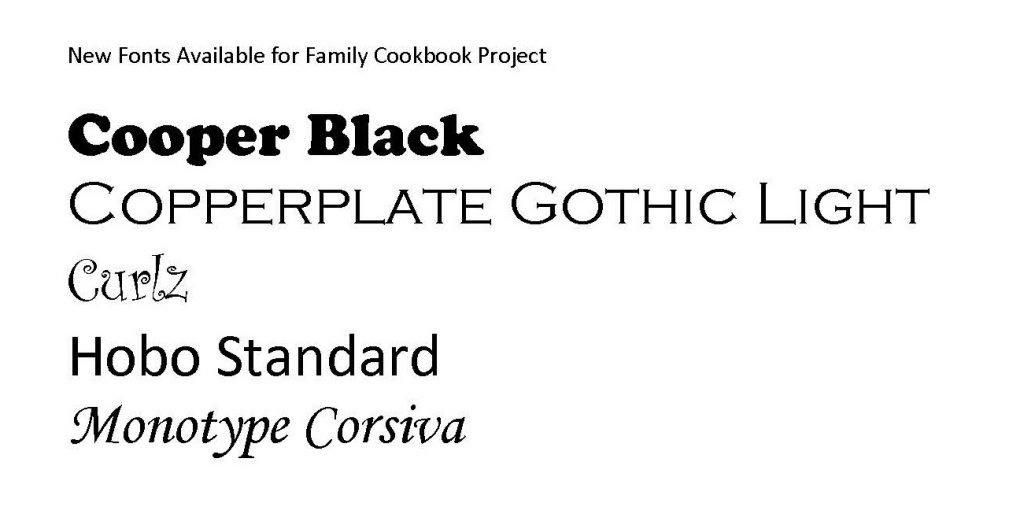Family Cookbook Project has added five new typefaces to the custom recipe layout options for cookbooks created using the Family Cookbook Project system.

Cooper Black is an ultra-bold serif typeface intended for display use that was designed by Oswald Bruce Cooper in 1922. Its use in pop culture increased worldwide since 1966, when the Beach Boys used it for the cover artwork of their album Pet Sounds. It was then featured in the Doors’ L.A. Woman (1971) and David Bowie’s Ziggy Stardust (1972), and in the opening credits of The Bob Newhart Show, Garfield, and M*A*S*H. As a result, Cooper Black has become emblematic of late-’60s/early-’70s style.
Copperplate Gothic is a typeface designed by Frederic W. Goudy in 1901. While termed a “Gothic” (another term for sans-serif), the face has small glyphic serifs that act to emphasize the blunt terminus of vertical and horizontal strokes. It was designed in capitals only, since the design was intended to be used for headings and key words rather than for body text.The typeface is often used in stationery, for social printing and business cards. It is also classically seen acid-etched into glass on the doors of law offices, banks and restaurants.
Curlz is a whimsical OpenType Font display typeface designed by Carl Crossgrove and Steve Matteson in 1995. While decorative and without a historical model, the face bears comparison with the Emigre foundry’s 1991 typeface Remedy.
Hobo Standard is a sans-serif typeface. It is unusual in having virtually no straight lines and no descenders. It was created by Morris Fuller Benton in 1910. There are several theories regarding the font’s name, and in fact it is widely recognized as one of the more interesting mysteries in typographic history. The most complete and most plausible theory demonstrates how Benton, who lived and worked near a large Russian community, must have seen a particular cigar poster spelling what appears to read like “HOBO!” (“ново”, Russian for “New!”). The poster’s hand-lettering of the word bears striking and unique resemblances to the font; the shape of the O at the extreme right of the poster was probably traced by Benton to match his own Capital O precisely, and those shapes helped define the design of the font.
Monotype Corsiva is an italic typeface made in the style of the early Italian cursives, as exemplified by the work of the writing master Ludovico degli Arrighi in the sixteenth century. The capitals are of swash design, with characteristic flourishes, designed primarily for use as initial letters. Corsiva can be used for short text passages in advertising but is best used to add sparkle to invitations, greeting cards and menus, and to give a sense of occasion to certificates and awards. This is also used on the Family Cookbook Project Recipe Tree cover option.
Monotype Corsiva joins seven original typefaces in the Family Cookbook Project Standard Recipe Layout Options: Times Roman, Arial, Comic Sans, Impact, Century Gothic Fancy, Script, and Palatino Centered. The other new type faces are available in the custom layout option for now.
Visit the Custom Recipe Layout option in the Layout and Design Center to see all of the typeface options.
